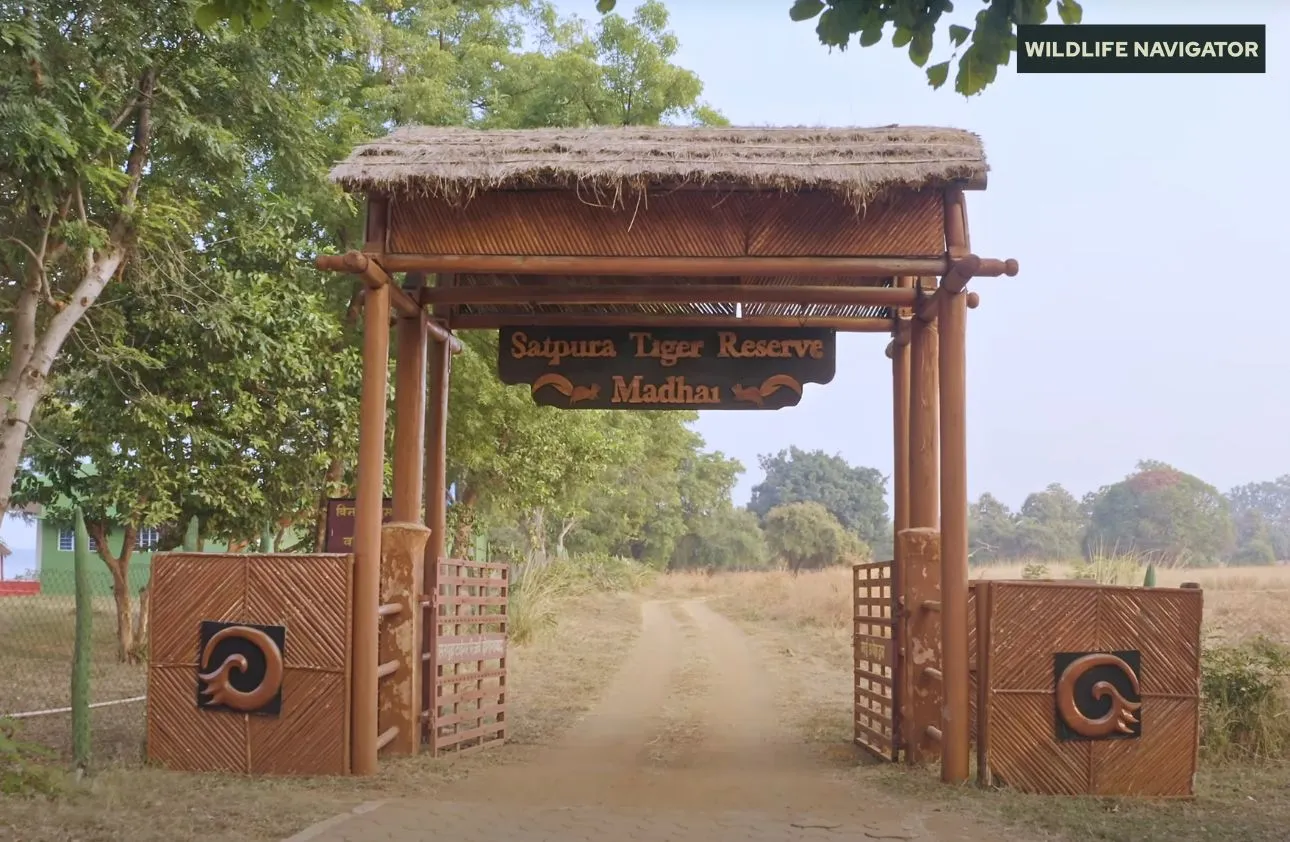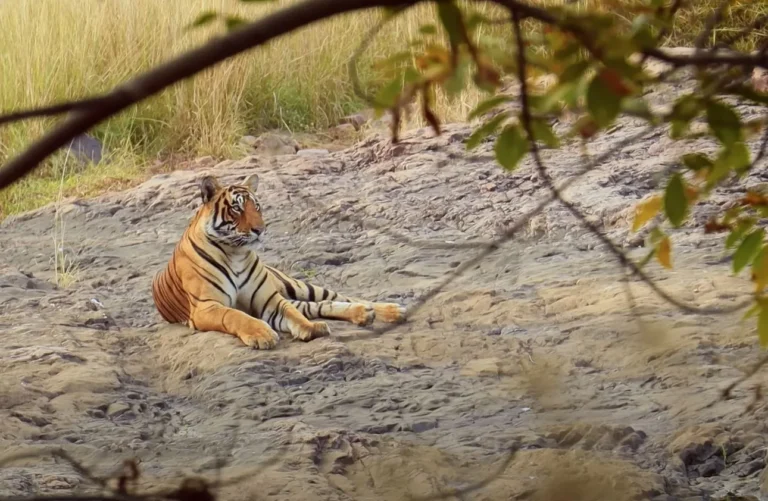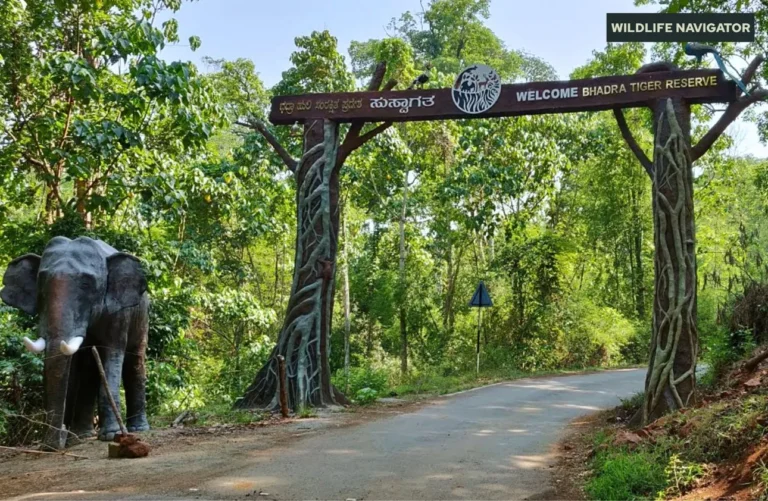Satpura National Park & Tiger Reserve – Complete Travel Guide

Satpura National Park is one of India’s most unique and underrated wildlife destinations, located in the heart of Madhya Pradesh. Spread across the rugged terrain of the Satpura ranges, this park offers an unparalleled blend of dense forests, deep valleys, cascading waterfalls, and meandering rivers. Unlike the more crowded national parks of India, Satpura is celebrated for its peaceful environment, offbeat safaris, and immersive wildlife experiences.
What makes Satpura truly stand out is the variety of safaris it offers—walking safaris, canoe safaris, jeep safaris, and even night safaris—making it one of the few parks in India where visitors can explore wildlife beyond the traditional jeep experience. This uniqueness, coupled with its rich biodiversity that includes tigers, leopards, sloth bears, wild dogs, and over 300 bird species, has earned Satpura a reputation as a haven for both nature lovers and adventure seekers.
For travellers looking to step away from the usual tourist circuits and experience wildlife in its raw, untouched form, Satpura National Park is an absolute gem waiting to be discovered.
History, Geography and Landscape of Satpura National Park
Satpura National Park was established in 1981 and forms a crucial part of the Satpura Tiger Reserve, which also includes the Bori Wildlife Sanctuary and Pachmarhi Wildlife Sanctuary. Together, these protected areas cover over 2,200 square kilometres, making it one of the largest and most significant tiger reserves in central India.
The name Satpura comes from the Sanskrit words Sat (seven) and Pura (mountains), referring to the seven mountain folds of the Satpura ranges. This rugged terrain creates a diverse landscape of sandstone peaks, narrow gorges, ravines, and caves, making it both a natural fortress for wildlife and a paradise for explorers.
Geographically, the park lies in the Hoshangabad district of Madhya Pradesh, at an altitude ranging from 300 to 1,352 meters above sea level. The Denwa River flows along its boundary, enhancing the park’s scenic charm and serving as a lifeline for animals. Visitors often find the contrast of dense sal and teak forests with open grasslands and tranquil riverbanks mesmerising.
Unlike many tiger reserves that are primarily flat plains, Satpura’s undulating terrain, plateaus, and valleys create a mosaic of habitats. This allows it to support a wide range of wildlife species, from large predators to rare reptiles and migratory birds.
With its unique blend of natural beauty, geological diversity, and historical importance (ancient rock paintings and caves can be found here), Satpura National Park stands out as a destination where both culture and wilderness coexist.
Flora and Fauna of Satpura National Park
Satpura National Park is often described as a biodiversity hotspot of central India, thanks to its unique mix of landscapes and habitats. The park’s dense forests, river valleys, grasslands, and rocky plateaus support a rich variety of plant and animal life that makes every safari here full of surprises.
Flora
The park’s vegetation is a mix of moist deciduous, dry deciduous, and mixed forests, dominated by teak (Tectona grandis) and sal (Shorea robusta). You’ll also find bamboo thickets, medicinal plants, and rare herbs scattered across the forest floor.
In certain areas, especially near streams, the lush greenery is complemented by mahua, tendu, and jamun trees, which also provide food for wildlife. During spring and summer, flowering trees like palash (flame of the forest) add vibrant splashes of red and orange to the landscape.
Fauna
Satpura is home to over 50 species of mammals, 300+ bird species, 30 species of reptiles, and countless insects and butterflies.
- Major Mammals:
- Tiger – Though sightings are rarer compared to Bandhavgarh or Kanha, the park’s tigers roam freely in its rugged terrain.
- Leopard – More commonly seen than tigers, often near rocky outcrops.
- Sloth Bear – One of the highlights of Satpura; sightings are frequent.
- Indian Wild Dog (Dhole) – Satpura is among the best places in India to spot these endangered predators.
- Other species – Gaur (Indian bison), sambar deer, chital (spotted deer), nilgai, four-horned antelope, and langurs.
- Birdlife:
Satpura is a birdwatcher’s paradise. From Indian Skimmers and Malabar Pied Hornbills to migratory waterfowl, the park offers endless opportunities. Raptors like crested serpent eagles, grey-headed fish eagles, and harriers can also be spotted. - Reptiles & Others:
Marsh crocodiles bask along the Denwa River, while monitor lizards and various snakes thrive in the rocky terrain.
The diversity of Satpura’s flora and fauna ensures that every safari—whether on foot, by jeep, or by canoe—offers a different perspective of the wild. For many wildlife enthusiasts, spotting a sloth bear or wild dog here is just as thrilling as seeing a tiger.
Safari Options in Satpura National Park
Satpura National Park is unique in India for the variety of safaris it offers. While most national parks in the country restrict visitors to jeep safaris, Satpura goes a step further by introducing walking, canoe, and even night safaris—offering a deeper, more intimate connection with nature.
Here are the main safari options available:
Jeep Safari
- The most popular way to explore the park.
- Takes visitors deep into the core zones through rugged terrain, valleys, and river crossings.
- Great for spotting leopards, sloth bears, and a variety of herbivores.
- Morning and evening slots available.
Walking Safari
- One of the rarest and most exciting experiences in Indian national parks.
- Visitors, guided by trained naturalists, explore the forest on foot.
- Offers a chance to observe smaller wildlife, plants, and birdlife up close.
- Perfect for nature lovers and photographers who enjoy a slower pace.
Canoe Safari
- Conducted on the calm waters of the Denwa River.
- Provides a peaceful way to spot aquatic birds, crocodiles, and animals drinking by the riverbanks.
- Ideal for birdwatchers and those seeking a serene experience.
Night Safari
- Available in the buffer zone.
- Offers a chance to witness nocturnal animals like civets, porcupines, owls, and sometimes leopards on the move.
- A thrilling adventure for those who want to experience the forest after dark.
Elephant Safari (Occasional)
- Limited and mainly organised for research or special purposes.
- Provides a unique vantage point to observe wildlife, but less common compared to other safaris.
Satpura’s diverse safari options make it stand out from other parks like Kanha or Bandhavgarh, where only jeep safaris are allowed. This variety ensures that visitors can experience the forest from multiple perspectives—by land, by water, and even on foot—making every visit memorable.
Best Time to Visit Satpura National Park
Satpura National Park is open to visitors from October to June, with each season offering a different kind of experience. Choosing the right time depends on whether you prefer pleasant weather, lush greenery, or the thrill of spotting predators.
Winter (October – February)
- Weather: Cool and pleasant, with temperatures ranging from 8°C to 25°C.
- Experience: Ideal for safaris, birdwatching, and photography. Migratory birds arrive during this time, making it a paradise for bird lovers.
- Best For: Families, wildlife enthusiasts, and those who enjoy comfortable weather.
Summer (March – June)
- Weather: Hot, with temperatures rising up to 40°C in May–June.
- Experience: Despite the heat, summer is the best season for tiger and predator sightings as animals gather near water sources. The forest becomes drier, improving visibility.
- Best For: Hardcore wildlife photographers and those keen on big cat sightings.
Monsoon (July – September)
- Weather: Heavy rains, lush greenery, and high humidity.
- Experience: The park remains closed during monsoon for visitor safety and to allow the forest to rejuvenate.
- Best For: Off-season travellers who wish to explore Pachmarhi (nearby hill station) and surrounding areas.
Best Overall Time to Visit: November to March for pleasant weather and birdwatching, or April to June for serious wildlife sightings.
Entry Fees & Timings of Satpura National Park
Like most Indian national parks, entry to Satpura is regulated through tickets and safari bookings, which help manage tourism and conserve the fragile ecosystem. The fees vary depending on nationality, type of safari, and vehicle choice.
Entry Fees (Approximate)
- Indians (Adults): ₹300–500 per person
- Foreign Nationals: ₹1,500–2,000 per person
- Children below 5 years: Free (charges may apply for safari seats)
- Still Camera: Usually free or a nominal ₹100
- Video/Professional Camera: Extra charges may apply
(Note: Fees may vary depending on booking platforms and recent forest department updates.)
Safari Charges (per Jeep, up to 6 people)
- Jeep Safari (Core Zone): ₹4,500–6,000 per jeep (includes guide & vehicle fee)
- Walking Safari: Around ₹2,000–3,000 per person
- Canoe Safari: ₹1,500–2,000 per person
- Night Safari (Buffer Zone): ₹3,000–4,500 per jeep
Park Timings
Satpura follows fixed safari timings, which vary slightly with the season:
- Morning Safari:
- Winter: 6:30 AM – 11:00 AM
- Summer: 5:30 AM – 10:00 AM
- Evening Safari:
- Winter: 2:30 PM – 5:30 PM
- Summer: 3:30 PM – 6:30 PM
- Night Safari (Buffer Zone): 7:00 PM – 10:00 PM
Tip: Safaris must be booked well in advance, especially during weekends and peak tourist season (November–March). Online bookings are available through the Madhya Pradesh Forest Department website and authorised portals.
How to Reach Satpura National Park
Satpura National Park is located in the Hoshangabad district of Madhya Pradesh, near the picturesque hill station of Pachmarhi. While it is relatively off the main tourist track, the park is well-connected by road, rail, and air via nearby cities.
By Air
- The nearest airport is Bhopal Airport (Raja Bhoj Airport), approximately 200 km from the park.
- Nagpur Airport is another option, around 250 km away.
- From the airport, visitors can hire a taxi or take a bus to Pachmarhi and Satpura.
By Train
- The closest railway station is Pipariya Railway Station, about 45 km from the park entrance.
- Pipariya is well-connected to major cities like Bhopal, Jabalpur, Nagpur, and Indore.
- From the station, taxis and buses are available to Pachmarhi and Satpura.
By Road
- Bhopal: 200 km (~5–6 hours by car or bus)
- Nagpur: 250 km (~6–7 hours by car)
- Jabalpur: 210 km (~5–6 hours by car)
- Regular state-run and private buses connect Bhopal, Nagpur, and Jabalpur to Pachmarhi.
- For Satpura, visitors usually continue by jeep or taxi from Pachmarhi, as the park entry is inside the forest area.
Tips for Road Travel
- Roads are mostly good, but forest roads can be narrow and winding.
- Hiring a local guide or driver familiar with the area is recommended.
- Early morning departures are advised to avoid traffic and to catch morning safaris.
Satpura’s relatively remote location adds to its charm, ensuring a peaceful wildlife experience far from crowded tourist circuits.
Accommodation Options Near Satpura National Park
Staying near Satpura National Park offers a range of options, from rustic forest lodges to luxury resorts, making it suitable for every type of traveller. Most accommodations are concentrated around Pachmarhi, the nearest town and hill station, which also serves as the gateway to the park.
Forest Rest Houses
- Managed by the Madhya Pradesh Forest Department.
- Offer basic yet comfortable rooms inside or near the park.
- Ideal for wildlife enthusiasts who want to stay close to nature.
- Booking usually requires advance reservations through the forest department website.
- Peak season (November–March) sees high demand; book well in advance.
Luxury Resorts & Eco-Lodges
- Several resorts near Pachmarhi provide modern amenities with eco-friendly designs.
- Features include guided safari packages, swimming pools, bonfire evenings, and nature trails.
- Popular for families, honeymooners, and wildlife photographers seeking comfort.
- Staying in Pachmarhi allows easy access to both the park and local attractions like waterfalls, caves, and viewpoints.
Budget Stays & Guesthouses
- Pachmarhi has affordable guesthouses, lodges, and homestays.
- Prices start from around ₹800–1,500 per night.
- While simpler in facilities, they are often run by locals and provide authentic experiences and local cuisine.
Camping & Nature Camps
- Some tour operators offer tented campsites inside the buffer zone.
- Ideal for adventure travellers and nature enthusiasts who want to sleep under the stars.
- For a truly immersive experience, consider forest rest houses or tented camps inside or near the park.
- Equipped with basic amenities and guided safari options.
Travel Tips for Satpura National Park
- Book in advance: Safaris and accommodations fill up quickly, especially during peak season (Nov–Mar).
- Carry essentials: Comfortable walking shoes, binoculars, camera, sunscreen, insect repellent, and water.
- Dress appropriately: Neutral-colored clothing is best for wildlife spotting.
- Follow park rules: Do not litter, feed animals, or stray from designated safari paths.
- Best times for wildlife: Early mornings and late afternoons.
- Local guides: Hire trained guides for better wildlife spotting and safety.
- Stay flexible: Weather and animal movement may affect safari schedules.
Conclusion
Satpura National Park is a hidden gem in the heart of India, offering a rare blend of adventure, tranquillity, and rich biodiversity. From the thrill of spotting wild tigers, leopards, and sloth bears to the serenity of canoeing along the Denwa River, every moment here connects you with nature in its purest form.
Unlike the more crowded parks, Satpura allows you to experience wildlife up close, whether on foot, by jeep, or by boat. Its rugged terrain, dense forests, and diverse flora and fauna make it a perfect destination for wildlife enthusiasts, birdwatchers, and adventure travellers alike.
If you’re seeking an offbeat wildlife adventure, where the forest feels untouched and every safari is an opportunity for discovery, Satpura National Park should be at the top of your travel list.





